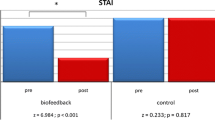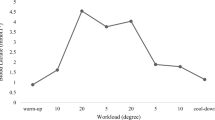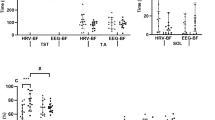Abstract
This pilot study examines the effect of heart rate variability (HRV) biofeedback on measures of electroencephalogram (EEG) during and immediately after biofeedback. Eighteen healthy males exposed to work-related stress, were randomised into an HRV biofeedback (BIO) or a comparative group (COM). EEG was recorded during the intervention and during rest periods before and after the intervention. Power spectral density in theta, alpha and beta frequency bands and theta/beta ratios were calculated. During the intervention, the BIO group had higher relative theta power [Fz and Pz (p < 0.01), Cz (p < 0.05)], lower fronto–central relative beta power (p < 0.05), and higher theta/beta [Fz and Cz (p < 0.01), Pz (p < 0.05)] than the COM group. The groups showed different responses after the intervention with increased posterior theta/beta (p < 0.05) in the BIO group and altered posterior relative theta (p < 0.05), central relative beta (p = 0.06) and central–posterior theta/beta (p < 0.01) in the post-intervention rest period. The findings of this study suggest that a single session of HRV biofeedback after a single training session was associated with changes in EEG suggestive of increased internal attention and relaxation both during and after the intervention. However, the comparative intervention was associated with changes suggestive of increased mental effort and possible anxiety during and after the intervention.




Similar content being viewed by others
References
Aftanas, L. I., & Golocheikine, S. A. (2001). Human anterior and frontal midline theta and lower alpha reflect emotionally positive state and internalized attention: High-resolution EEG investigation of meditation. Neuroscience Letters, 310, 57–60.
Aftanas, L. I., & Golocheikine, S. A. (2002). Non-linear dynamic complexity of the human EEG during meditation. Neuroscience Letters, 330, 143–146.
American Psychological Association. (2012). Stress tip sheet. Retrieved January 25, 2012 from http://www.apa.org/helpcenter/stress-tips.aspx.
Arambula, P., Peper, E., Kawakami, M., & Gibney, K. H. (2001). The physiological correlates of Kundalini Yoga meditation: A study of a yoga master. Applied Psychophysioloy and Biofeedback, 26, 147–153.
Astin, J. A., Shapiro, S. L., Eisenberg, D. M., & Forys, K. L. (2003). Mind-body medicine: State of the science, implications for practice. The Journal of the American Board of Family Practice, 16, 131–147.
Basar, E., Schurmann, M., Basar-Eroglu, C., & Karakas, S. (1997). Alpha oscillations in brain functioning: an integrative theory. International Journal of Psychophysiology, 26, 5–29.
Beauregard, M., & Paquette, V. (2008). EEG activity in Carmelite nuns during a mystical experience. Neuroscience Letters, 444, 1–4.
Beck, S. G., List, T. J., & Choi, K. C. (1994). Long- and short-term administration of corticosterone alters CA1 hippocampal neuronal properties. Neuroendocrinology, 60, 261–272.
Brismar, T. (2007). The human EEG–physiological and clinical studies. Physiology and Behaviour, 92, 141–147.
Cahn, B. R., & Polich, J. (2006). Meditation states and traits: EEG, ERP, and neuroimaging studies. Psychological Bulletin, 132, 180–211.
Chan, A. S., Han, Y. M., & Cheung, M. C. (2008). Electroencephalographic (EEG) measurements of mindfulness-based Triarchic body-pathway relaxation technique: a pilot study. Applied Psychophysiology and Biofeedback, 33, 39–47.
Chan, A. S., Sze, S. L., & Cheung, M. C. (2007). Quantitative electroencephalographic profiles for children with autistic spectrum disorder. Neuropsychology, 21, 74–81.
Corby, J. C., Roth, W. T., Zarcone, V. P., Jr., & Kopell, B. S. (1978). Psychophysiological correlates of the practice of Tantric Yoga meditation. Archives of General Psychiatry, 35, 571–577.
Cuevas, K., Raj, V., & Bell, M. A. (2012). A frequency band analysis of two-year-olds’ memory processes. International Journal of Psychophysiology, 83, 315–322.
Davidson, R. J., & Goleman, D. J. (1977). The role of attention in meditation and hypnosis: A psychobiological perspective on transformations of consciousness. International Journal of Clinical and Experimental Hypnosis, 25, 291–308.
Dunn, B. R., Hartigan, J. A., & Mikulas, W. L. (1999). Concentration and mindfulness meditations: Unique forms of consciousness? Applied Psychophysiology and Biofeedback, 24, 147–165.
Engel, A. K., & Fries, P. (2010). Beta-band oscillations–signalling the status quo? Current Opinion in Neurobiology, 20, 156–165.
Esch, T., Stefano, G. B., Fricchione, G. L., & Benson, H. (2002). The role of stress in neurodegenerative diseases and mental disorders. Neuroendocrinology Letters, 23, 199–208.
Gevins, A., Smith, M. E., McEvoy, L., & Yu, D. (1997). High-resolution EEG mapping of cortical activation related to working memory: Effects of task difficulty, type of processing, and practice. Cerebral Cortex, 7, 374–385.
Hebert, R., & Lehmann, D. (1977). Theta bursts: an EEG pattern in normal subjects practising the transcendental meditation technique. Electroencephalography and Clinical Neurophysiology, 42, 397–405.
Heilman, K. J., Handelman, M., Lewis, G., & Porges, S. W. (2008). Accuracy of the StressEraser in the detection of cardiac rhythms. Applied Psychophysiology and Biofeedback, 33, 83–89.
Howells, F. M., Stein, D. J., & Russell, V. A. (2010). Perceived mental effort correlates with changes in tonic arousal during attentional tasks. Behavioral and Brain Functions, 6, 39–53.
Inanaga, K. (1998). Frontal midline theta rhythm and mental activity. Psychiatry and Clinical Neurosciences, 52, 555–566.
Iramina, K., Ueno, S., & Matsuoka, S. (1996). MEG and EEG topography of frontal midline theta rhythm and source localization. Brain Topography, 8, 329–331.
Ishii, R., Shinosaki, K., Ukai, S., Inouye, T., Ishihara, T., Yoshimine, T., et al. (1999). Medial prefrontal cortex generates frontal midline theta rhythm. NeuroReport, 10, 675–679.
Jacobs, G. D., & Friedman, R. (2004). EEG spectral analysis of relaxation techniques. Applied Psychophysiology and Biofeedback, 29, 245–254.
Jacobs, G. D., & Lubar, J. F. (1989). Spectral analysis of the central nervous system effects of the relaxation response elicited by autogenic training. Behavioral Medicine, 15, 125–132.
Kendler, K. S., Karkowski, L. M., & Prescott, C. A. (1999). Causal relationship between stressful life events and the onset of major depression. American Journal of Psychiatry, 156, 837–841.
Khare, K. C., & Nigam, S. K. (2000). A study of electroencephalogram in meditators. Indian Journal of Physiology and Pharmacology, 44, 173–178.
Kiroy, V. N., Warsawskaya, L. V., & Voynov, V. B. (1996). EEG after prolonged mental activity. International Journal of Neuroscience, 85, 31–43.
Kirschbaum, C., Wolf, O. T., May, M., Wippich, W., & Hellhammer, D. H. (1996). Stress- and treatment-induced elevations of cortisol levels associated with impaired declarative memory in healthy adults. Life Sciences, 58, 1475–1483.
Klimesch, W. (1999). EEG alpha and theta oscillations reflect cognitive and memory performance: a review and analysis. Brain Research Reviews, 29, 169–195.
Knott, V. J., Bakish, D., Lusk, S., Barkely, J., & Perugini, M. (1996). Quantitative EEG correlates of panic disorder. Psychiatry Research, 68, 31–39.
Knyazev, G. G., Savostyanov, A. N., & Levin, E. A. (2005). Uncertainty, anxiety, and brain oscillations. Neuroscience Letters, 387, 121–125.
Kubota, Y., Sato, W., Toichi, M., Murai, T., Okada, T., Hayashi, A., et al. (2001). Frontal midline theta rhythm is correlated with cardiac autonomic activities during the performance of an attention demanding meditation procedure. Brain Research. Cognitive Brain Research, 11, 281–287.
Lazar, S. W., Bush, G., Gollub, R. L., Fricchione, G. L., Khalsa, G., & Benson, H. (2000). Functional brain mapping of the relaxation response and meditation. NeuroReport, 11, 1581–1585.
Lee, M. S., Bae, B. H., Ryu, H., Sohn, J. H., Kim, S. Y., & Chung, H. T. (1997). Changes in alpha wave and state anxiety during ChunDoSunBup Qi-training in trainees with open eyes. The American Journal of Chinese Medicine, 25, 289–299.
Lehrer, P. (2003). Applied psychophysiology: Beyond the boundaries of biofeedback (mending a wall, a brief history of our field, and applications to control of the muscles and cardiorespiratory systems). Applied Psychophysiology and Biofeedback, 28, 291–304.
Lehrer, P., Carr, R. E., Smetankine, A., Vaschillo, E., Peper, E., Porges, S., et al. (1997). Respiratory sinus arrhythmia versus neck/trapezius EMG and incentive inspirometry biofeedback for asthma: A pilot study. Applied Psychophysiology and Biofeedback, 22, 95–109.
Lehrer, P. M., Vaschillo, E., & Vaschillo, B. (2000). Resonant frequency biofeedback training to increase cardiac variability: Rationale and manual for training. Applied Psychophysiology and Biofeedback, 25, 177–191.
Lehrer, P. M., Vaschillo, E., Vaschillo, B., Lu, S. E., Eckberg, D. L., Edelberg, R., et al. (2003). Heart rate variability biofeedback increases baroreflex gain and peak expiratory flow. Psychosomatic Medicine, 65, 796–805.
Lehrer, P. M., Woolfolk, R. L., Rooney, A. J., McCann, B., & Carrington, P. (1983). Progressive relaxation and meditation. A study of psychophysiological and therapeutic differences between two techniques. Behavioral Research and Therapy, 21, 651–662.
Lou, H. C., Kjaer, T. W., Friberg, L., Wildschiodtz, G., Holm, S., & Nowak, M. (1999). A 15O–H2O PET study of meditation and the resting state of normal consciousness. Human Brain Mapping, 7, 98–105.
Lupien, S. J., Gaudreau, S., Tchiteya, B. M., Maheu, F., Sharma, S., Nair, N. P., et al. (1997). Stress-induced declarative memory impairment in healthy elderly subjects: Relationship to cortisol reactivity. Journal of Clinical Endocrinology and Metabolism, 82, 2070–2075.
Matthews, S. C., Paulus, M. P., Simmons, A. N., Nelesen, R. A., & Dimsdale, J. E. (2004). Functional subdivisions within anterior cingulate cortex and their relationship to autonomic nervous system function. Neuroimage, 22, 1151–1156.
Mikosch, P., Hadrawa, T., Laubreiter, K., Brandl, J., Pilz, J., Stettner, H., et al. (2010). Effectiveness of respiratory-sinus-arrhythmia biofeedback on state-anxiety in patients undergoing coronary angiography. Journal of Advanced Nursing, 66, 1101–1110.
Mizuki, Y., Suetsugi, M., Ushijima, I., & Yamada, M. (1997). Differential effects of dopaminergic drugs on anxiety and arousal in healthy volunteers with high and low anxiety. Progress in Neuro-Psychopharmacology and Biological Psychiatry, 21, 573–590.
Muench, F. (2008). The portable StressEraser heart rate variability biofeedback device: Background and research. Biofeedback, 36, 35–39.
Myslobodsky, M. S., Coppola, R., Bar-Ziv, J., Karson, C., Daniel, D., van Praag, H., et al. (1989). EEG asymmetries may be affected by cranial and brain parenchymal asymmetries. Brain Topography, 1, 221–228.
National Institute of Mental Health. (2012). Any anxiety disorder among adults. Retrieved January 25, 2012 from http://www.nimh.nih.gov/statistics/1ANYANX_ADULT.shtml.
Niedermeyer, E. (1997). Alpha rhythms as physiological and abnormal phenomena. International Journal of Psychophysiology, 26, 31–49.
Palva, S., & Palva, J. M. (2007). New vistas for alpha-frequency band oscillations. Trends in Neuroscience, 30, 150–158.
Pieper, C., LaCroix, A. Z., & Karasek, R. A. (1989). The relation of psychosocial dimensions of work with coronary heart disease risk factors: A meta-analysis of five United States data bases. American Journal of Epidemiology, 129, 483–494.
Posner, M. I., & Petersen, S. E. (1990). The attention system of the human brain. Annual Review of Neuroscience, 13, 25–42.
Prinsloo, G. E., Rauch, H. G., Lambert, M. I., Muench, F., Noakes, T. D., & Derman, W. E. (2011). The effect of short duration heart rate variability (HRV) biofeedback on cognitive performance during laboratory induced cognitive stress. Applied Cognitive Psychology, 25, 792–801.
Reiner, R. (2008). Integrating a portable biofeedback device into clinical practice for patients with anxiety disorders: Results of a pilot study. Applied Psychophysiology and Biofeedback, 33, 55–61.
Sauseng, P., Hoppe, J., Klimesch, W., Gerloff, C., & Hummel, F. C. (2007). Dissociation of sustained attention from central executive functions: Local activity and interregional connectivity in the theta range. European Journal of Neuroscience, 25, 587–593.
Sherlin, L., Muench, F., & Wyckoff, S. (2010). Respiratory sinus arrhythmia feedback in a stressed population exposed to a brief stressor demonstrated by quantitative EEG and sLORETA. Applied Psychophysiology and Biofeedback, 35, 219–228.
Smith, J. C. (2010). Smith relaxation states inventory 3 (SRSI3). Raleigh, NC: LuluPress.
Spielberger, C. (1983). Manual for the state-trait anxiety inventory. Palo Alto, CA: Consulting Psychologists Press.
Stancak, A., Jr., Kuna, M., Srinivasan, D. C., & Vishnudevananda, S. (1991). Kapalabhati–yogic cleansing exercise. II. EEG topography analysis. Homeostasis in Health and Disease, 33, 182–189.
Stroop, J. R. (1935). Studies of interference in serial verbal reactions. Journal of Experimental Psychology: Human Perception and Performance, 18, 643–662.
Suetsugi, M., Mizuki, Y., Ushijima, I., Kobayashi, T., Tsuchiya, K., Aoki, T., et al. (2000). Appearance of frontal midline theta activity in patients with generalized anxiety disorder. Neuropsychobiology, 41, 108–112.
Takahashi, T., Murata, T., Hamada, T., Omori, M., Kosaka, H., Kikuchi, M., et al. (2005). Changes in EEG and autonomic nervous activity during meditation and their association with personality traits. International Journal of Psychophysiology, 55, 199–207.
Tang, Y. Y., Ma, Y., Fan, Y., Feng, H., Wang, J., Feng, S., et al. (2009). Central and autonomic nervous system interaction is altered by short-term meditation. Proceedings of the National Academy of Sciences of the United States of America, 106, 8865–8870.
Task Force of the European Society of Cardiology and the North America Society of Pacing and Electrophysiology. (1996). Heart rate variability. Standards of measurement, physiological interpretation, and clinical use. European Heart Journal, 17, 354–381.
Travis, F., & Wallace, R. K. (1999). Autonomic and EEG patterns during eyes-closed rest and transcendental meditation (TM) practice: The basis for a neural model of TM practice. Consciousness and Cognition, 8, 302–318.
Vaschillo, E. G., Vaschillo, B., & Lehrer, P. (2006). Characteristics of resonance in heart rate variability stimulated by biofeedback. Applied Psychophysiology and Biofeedback, 31, 129–142.
Yildiz, M., & Ider, Y. Z. (2006). Model based and experimental investigation of respiratory effect on the HRV power spectrum. Physiological Measurement, 27, 973–988.
Zhang, J. Z., Li, J. Z., & He, Q. N. (1988). Statistical brain topographic mapping analysis for EEGs recorded during Qi Gong state. International Journal of Neuroscience, 38, 415–425.
Acknowledgments
We would like to thank Helicor for providing funding for this study. We receive no remuneration for merchandise sold and therefore have no vested interest in the outcome of the study.
Author information
Authors and Affiliations
Corresponding author
Rights and permissions
About this article
Cite this article
Prinsloo, G.E., Rauch, H.G.L., Karpul, D. et al. The Effect of a Single Session of Short Duration Heart Rate Variability Biofeedback on EEG: A Pilot Study. Appl Psychophysiol Biofeedback 38, 45–56 (2013). https://doi.org/10.1007/s10484-012-9207-0
Published:
Issue Date:
DOI: https://doi.org/10.1007/s10484-012-9207-0




